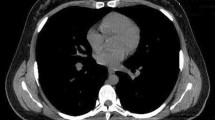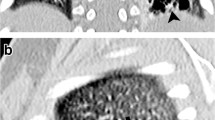Abstract
Objective
The aim of this study was to evaluate the safe zone for performing blind sternal procedures based on computed tomography (CT) evaluation of congenital midline sternal foramina using multidetector computed tomography (MDCT).
Materials and methods
This retrospective study was carried out on 1,180 patients who underwent MDCT of the thorax from March 2015 to February 2016. The MDCT images were evaluated in axial and reformatted planes. Morphometry and prevalence of midline congenital sternal foramina (SF) and manubrio-foraminal distance (MFD) were evaluated. The safe zone was defined for a blinded intervention, based on palpable anatomical landmarks. Data were presented in terms of percentage, mean ± standard deviation and calculations were carried out using Microsoft Excel.
Results
The prevalence of SF in our study sample was 11.6 %. The majority of SF were located in a typical position in the lower sternal body at the level of fifth costo-chondral junction (CCJ) in 108 patients (78.8 %). The structure directly beneath the SF was mediastinal fat in 73 patients (53.3 %), followed by anterior pericardium in 44 patients (32.1 %) and lung parenchyma in 20 patients (14.6 %). The mean MFD in our study population was 11.90 ± 1.31 cm.
Conclusions
Sternal interventions should be avoided at the level of fourth to sixth CCJ, which is considered the danger zone. An intervention at the fourth to sixth CCJ may lead to disastrous consequences in patients who have SF.












Similar content being viewed by others
References
Ashley GT. The relationship between the pattern of ossification and the definitive shape of the mesosternum in man. J Anat. 1956;90(1):87–105.
Van Marum RJ, Velde LT. Cardiac tamponade following sternal puncture in two patients. Neth J Med. 2001;59(1):39–40.
Halvorsen TB, Anda SS, Naess AB, Levang OW. Fatal cardiac tamponade after acupuncture through congenital sternal foramen. Lancet. 1995;345(8958):1175.
Yekeler E, Tunaci M, Tunaci A, Dursun M, Acunas G. Frequency of sternal variations and anomalies evaluated by MDCT. Am J Roentgenol. 2006;186:956–60.
Taylor HL. The sternal foramen: the possible forensic misinterpretation of an anatomic abnormality. J Forensic Sci. 1974;19(4):730–4.
Saccheri P, Sabbadini G, Toso F, Travan L. A keyhole shaped sternal defect in an ancient human skeleton. Surg Radiol Anat. 2012;34(10):965.
McCormick WF. Sternal foramena in man. Am J Forensic Med Pathol. 1981;2:249–52.
Fokin AA. Cleft sternum and sternal foramen. Chest Surg Clin N Am. 2000;10:261–76.
Shivakumar GL, Deepa G, Kadlimatti HS. Variations in human sterna. J Evol Med Dent Sci. 2013;2(2):99–104.
Moore MK, Stewart JH, McCormick WF. Anomalies of the human chest plate area: radiographic findings in a large autopsy population. Am J Forensic Med Pathol. 1988;9(4):348–54.
Cooper PD, Stewart JH, McCormick WF. Development and morphology of the sternal foramen. Am J Forensic Med Pathol. 1988;9(4):342–7.
Stark P. Midline sternal foramen: CT demonstration. J Comput Assist Tomogr. 1985;9:489–90.
Collin T, Cox C. Chest wall and breast. In: Standring S, editor. Gray’s anatomy: the anatomical basis of clinical practice. 40th ed. Edinburgh: Churchill Livingstone Elsevier; 2008. p. 917–18.
Pevenage P, De Maeseneer M, Muylle K, Osteaux M. Sternal foramen simulating osteolytic lesion on scintigraphy and SPET imaging. Ann Nucl Med Sci. 2002;15(4):227–30.
Aktan ZA, Savas R. Anatomic and HRCT. Demonstration of midline sternal foramina. Turk J Med Sci. 1998;28:511–4.
Babinski MA, Rafael FA, Steil AD, et al. High prevalence of sternal foramen: quantitative, anatomical analysis and its clinical implications in acupuncture practice. Int J Morphol. 2012;30(3):1042–9.
Kirchgatterer A, Schwarz D, Hoeller E. Cardiac tamponade following acupuncture. Chest. 2000;117:1510–1.
Ishii S, Shishido F, Miyajima M, et al. Causes of photopenic defects in the lower sternum on bone scintigraphy and correlation with multidetector CT. Clin Nucl Med. 2011;36(5):355–8.
Wolochow MS. Fatal cardiac tamponade through congenital sternal foramen. Lancet. 1995;346:442.
Pascali VL, Lazzaro P, Fiori A. Is sternal bone marrow needle biopsy still a hazardous technique? Report of three further fatal cases. Am J Forensic Med Pathol. 1987;8:42–4.
Cheng TO. Pericardial effusion from self-inserted needle in the heart. Eur Heart J. 1991;12:958.
Teitelbaum SL. Twenty years’ experience with intrinsic tumors of the bony thorax at a large institution. J Thorac Cardiovasc Surg. 1972;63:776.
Acknowledgements
We acknowledge Dr Hiranya Saikia (statistician), Dr B. Hazarika (chest physician, Dr G. Kushre (anatomist), Dr M. Talukdar (cardiothoracic surgeon) of Assam Medical College for guiding us in carrying this study.
Author information
Authors and Affiliations
Corresponding author
Ethics declarations
Conflicts of interest
The authors declare that they have no conflicts of interest.
Funding
None.
Rights and permissions
About this article
Cite this article
Boruah, D.K., Prakash, A., Yadav, R.R. et al. The safe zone for blinded sternal interventions based on CT evaluation of midline congenital sternal foramina. Skeletal Radiol 45, 1619–1628 (2016). https://doi.org/10.1007/s00256-016-2473-9
Received:
Revised:
Accepted:
Published:
Issue Date:
DOI: https://doi.org/10.1007/s00256-016-2473-9




